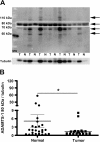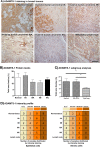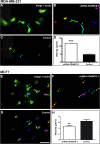Decreased expression of ADAMTS-1 in human breast tumors stimulates migration and invasion
- PMID: 23289900
- PMCID: PMC3600045
- DOI: 10.1186/1476-4598-12-2
Decreased expression of ADAMTS-1 in human breast tumors stimulates migration and invasion
Abstract
Background: ADAMTS-1 (a disintegrin and metalloprotease with thrombospondin motifs) is a member of the ADAMTS family of metalloproteases. Here, we investigated mRNA and protein levels of ADAMTS-1 in normal and neoplastic tissues using qPCR, immunohistochemistry and immunoblot analyses, and we addressed the role of ADAMTS-1 in regulating migration, invasion and invadopodia formation in breast tumor cell lines.
Results: In a series of primary breast tumors, we observed variable levels of ADAMTS-1 mRNA expression but lower levels of ADAMTS-1 protein expression in human breast cancers as compared to normal tissue, with a striking decrease observed in high-malignancy cases (triple-negative for estrogen, progesterone and Her-2). This result prompted us to analyze the effect of ADAMTS-1 knockdown in breast cancer cells in vitro. MDA-MB-231 cells with depleted ADAMTS-1 expression demonstrated increased migration, invasion and invadopodia formation. The regulatory mechanisms underlying the effects of ADAMTS-1 may be related to VEGF, a growth factor involved in migration and invasion. MDA-MB-231 cells with depleted ADAMTS-1 showed increased VEGF concentrations in conditioned medium capable of inducing human endothelial cells (HUVEC) tubulogenesis. Furthermore, expression of the VEGF receptor (VEGFR2) was increased in MDA-MB-231 cells as compared to MCF7 cells. To further determine the relationship between ADAMTS-1 and VEGF regulating breast cancer cells, MDA-MB-231 cells with reduced expression of ADAMTS-1 were pretreated with a function-blocking antibody against VEGF and then tested in migration and invasion assays; both were partially rescued to control levels.
Conclusions: ADAMTS-1 expression was decreased in human breast tumors, and ADAMTS-1 knockdown stimulated migration, invasion and invadopodia formation in breast cancer cells in vitro. Therefore, this series of experiments suggests that VEGF is involved in the effects mediated by ADAMTS-1 in breast cancer cells.
Figures









Similar articles
-
Metalloproteinase-dependent and -independent processes contribute to inhibition of breast cancer cell migration, angiogenesis and liver metastasis by a disintegrin and metalloproteinase with thrombospondin motifs-15.Int J Cancer. 2015 Feb 15;136(4):E14-26. doi: 10.1002/ijc.29129. Epub 2014 Aug 18. Int J Cancer. 2015. PMID: 25099234
-
Progesterone acts via the progesterone receptor to induce adamts proteases in ovarian cancer cells.J Ovarian Res. 2016 Feb 25;9:9. doi: 10.1186/s13048-016-0219-x. J Ovarian Res. 2016. PMID: 26916548 Free PMC article.
-
Anti-angiogenic properties of ADAMTS-4 in vitro.Int J Exp Pathol. 2012 Feb;93(1):70-7. doi: 10.1111/j.1365-2613.2011.00802.x. Int J Exp Pathol. 2012. PMID: 22264287 Free PMC article.
-
Downregulation of RhoGDIα increased migration and invasion of ER (+) MCF7 and ER (-) MDA-MB-231 breast cancer cells.Cell Adh Migr. 2013 May-Jun;7(3):297-303. doi: 10.4161/cam.24204. Epub 2013 Apr 5. Cell Adh Migr. 2013. PMID: 23563506 Free PMC article.
-
Expression and prognosis of ADAMTS18 in different tumors.Front Oncol. 2024 Feb 28;14:1347633. doi: 10.3389/fonc.2024.1347633. eCollection 2024. Front Oncol. 2024. PMID: 38482210 Free PMC article. Review.
Cited by
-
The Long Noncoding RNA MALAT-1 Is Highly Expressed in Ovarian Cancer and Induces Cell Growth and Migration.PLoS One. 2016 May 26;11(5):e0155250. doi: 10.1371/journal.pone.0155250. eCollection 2016. PLoS One. 2016. PMID: 27227769 Free PMC article.
-
Galnt1 is required for normal heart valve development and cardiac function.PLoS One. 2015 Jan 23;10(1):e0115861. doi: 10.1371/journal.pone.0115861. eCollection 2015. PLoS One. 2015. PMID: 25615642 Free PMC article.
-
Modeling of hypo/hyperglycemia and their impact on breast cancer progression related molecules.PLoS One. 2014 Nov 17;9(11):e113103. doi: 10.1371/journal.pone.0113103. eCollection 2014. PLoS One. 2014. PMID: 25401697 Free PMC article.
-
Germline variation in ADAMTSL1 is associated with prognosis following breast cancer treatment in young women.Nat Commun. 2017 Nov 21;8(1):1632. doi: 10.1038/s41467-017-01775-y. Nat Commun. 2017. PMID: 29158497 Free PMC article.
-
Metalloprotease ADAMTS-1 decreases cell migration and invasion modulating the spatiotemporal dynamics of Cdc42 activity.Cell Signal. 2021 Jan;77:109827. doi: 10.1016/j.cellsig.2020.109827. Epub 2020 Nov 6. Cell Signal. 2021. PMID: 33161094 Free PMC article.
References
Publication types
MeSH terms
Substances
LinkOut - more resources
Full Text Sources
Other Literature Sources
Medical
Research Materials
Miscellaneous

